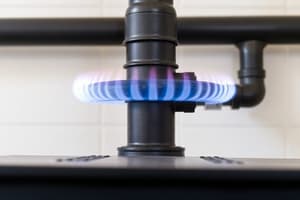Podcast
Questions and Answers
Which method is suitable for detecting carbon dioxide (CO2), carbon monoxide (CO), sulfur and nitrogen compounds, methane, and other hydrocarbons?
Which method is suitable for detecting carbon dioxide (CO2), carbon monoxide (CO), sulfur and nitrogen compounds, methane, and other hydrocarbons?
- Non-dispersive infrared (NDIR) (correct)
- Optical (fluorescence)
- Electro-galvanic
- Electro-chemical
Which gas compounds are not detected by the non-dispersive infrared (NDIR) method?
Which gas compounds are not detected by the non-dispersive infrared (NDIR) method?
- Methane and hydrocarbons
- All gases are detected by NDIR
- Oxygen, hydrogen, and nitrogen (correct)
- Carbon dioxide, carbon monoxide, and sulfur
Which method is commonly used for nitrogen oxides (NOx) detection?
Which method is commonly used for nitrogen oxides (NOx) detection?
- Chemiluminescent (correct)
- Electro-galvanic
- Optical (fluorescence)
- Electro-chemical
Which type of flue gas analysis involves sending a light source across the interior diameter of the stack to a detector?
Which type of flue gas analysis involves sending a light source across the interior diameter of the stack to a detector?
Which type of flue gas analysis is performed by inserting a probe into the stack at a precise point for measurements?
Which type of flue gas analysis is performed by inserting a probe into the stack at a precise point for measurements?
Which type of extractive monitoring involves continuously extracting and transporting the flue gas from the sampling point, through a conditioner, and to the analyzer?
Which type of extractive monitoring involves continuously extracting and transporting the flue gas from the sampling point, through a conditioner, and to the analyzer?
Which technology uses infrared sensors where light of a known wavelength is absorbed by a gas to analyze flue gas components?
Which technology uses infrared sensors where light of a known wavelength is absorbed by a gas to analyze flue gas components?
Which of the following is NOT a typical automatic flue gas analyzer?
Which of the following is NOT a typical automatic flue gas analyzer?
What is the difference between wet analysis and dry analysis of flue gas samples?
What is the difference between wet analysis and dry analysis of flue gas samples?
What is in situ monitoring?
What is in situ monitoring?
Flashcards are hidden until you start studying
Study Notes
Flue Gas Analysis Methods
- Non-dispersive infrared (NDIR) method is suitable for detecting carbon dioxide (CO2), carbon monoxide (CO), sulfur and nitrogen compounds, methane, and other hydrocarbons.
- NDIR method does not detect nitrogen oxides (NOx), ammonia (NH3), and hydrogen sulfide (H2S).
Nitrogen Oxides (NOx) Detection
- Chemiluminescence method is commonly used for NOx detection.
Flue Gas Analysis Techniques
- In-situ method involves sending a light source across the interior diameter of the stack to a detector.
- Extractive method involves inserting a probe into the stack at a precise point for measurements.
- Extractive monitoring involves continuously extracting and transporting the flue gas from the sampling point, through a conditioner, and to the analyzer.
Infrared Technology
- Infrared sensors use light of a known wavelength that is absorbed by a gas to analyze flue gas components.
Automatic Flue Gas Analyzers
- None of the following are typical automatic flue gas analyzers: gas chromatographs, mass spectrometers, and titrators.
Flue Gas Analysis Types
- Wet analysis involves the use of a liquid solvent to extract the analyte from the flue gas sample.
- Dry analysis involves the use of a solid or semi-solid material to extract the analyte from the flue gas sample.
In Situ Monitoring
- In situ monitoring involves the analysis of flue gas components directly within the stack, without the need for sample extraction or transport.
Studying That Suits You
Use AI to generate personalized quizzes and flashcards to suit your learning preferences.





